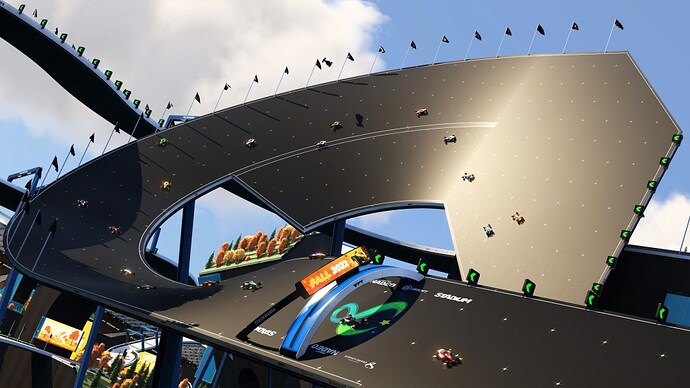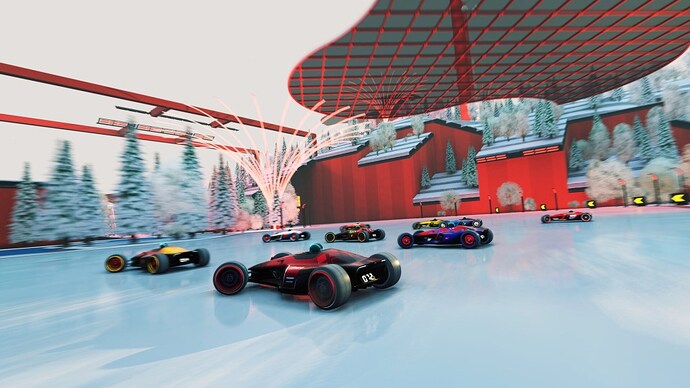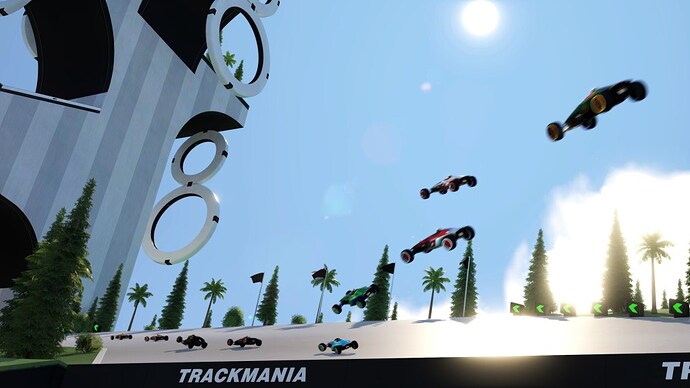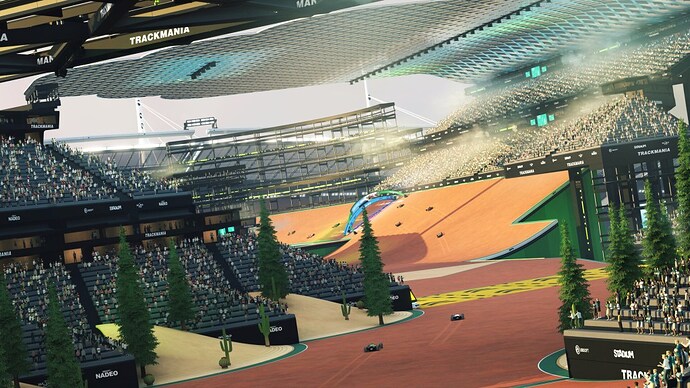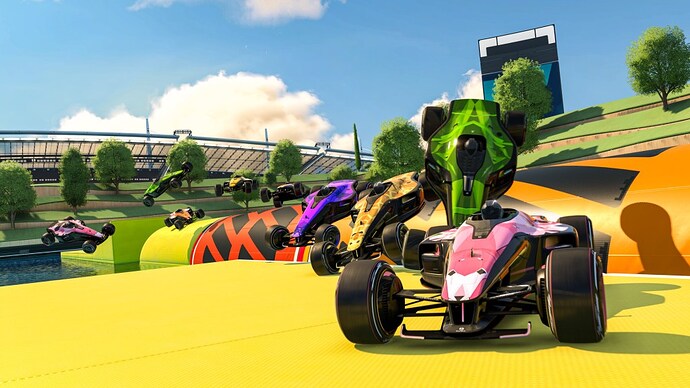Originally published at: Review | TrackMania - XboxEra
20 years after the launch of the first TrackMania on PC, finally comes to console the 2020 reboot of Nadeo’s iconic racing series – under the Ubisoft banner this time. Xbox players may still have fond memories of the only installment of the franchise to hit their console thus far, that being TrackMania Turbo in 2016 that’s also been a Games With Gold and a mainstay in my Quick Resume. This new chapter goes back to the roots, reinventing the Stadium environment once again and making it… GAAS-y? 3 years into this popular reboot’s PC life, it’s time to check out how it fares on Xbox Series X and Series S!
To build a track, you need an arena…
For an outsider, TrackMania is certainly not an easy to understand franchise, with overlapping names, games skipping platforms, long-supported versions and abandoned branches. What’s most relevant here is that TrackMania 2, under the ManiaPlanet banner that’s been the franchise’s main hub on PC for a good decade or so, is no more. The new TrackMania, which we’ll call TrackMania (2020) or TM2020 from now on for convenience, is on a brand new iteration of the game’s engine, and is now made as a game as a service. The base game is free, with two rather affordable subscription models available: a Standard access for merely 10 USD/EUR per year that gives access to all tracks, game modes and more, and a slightly more expensive 25 USD/EUR one that also gives access to custom servers, clubs and more. Free players still get to play each 3 month season’s official 25 tracks and most of the public servers, so it’s still a great starting point for those wetting their toes in this unique racing franchise for the very first time.
TrackMania is, indeed, a racing game like no other. First off, it is a time trial game, so your only real opponent is only really the clock. Each track features bronze, silver and gold medals, on top of an author medal which is the trackmaker’s validation time on said course. While real-time battles against other players exist, it’s all about the individual performance on tricky and twisty tracks – as such, there are no collisions but only ghosts, and even the physics are completely deterministic. This means that an exact sequence of inputs will always result in the exact same result. That’s why, one of the most popular track styles in this game were always the so-called Press Forward tracks: courses where, due to the predetermined physics of the game, track creators manage to build highly spectacular “scripted” sequences in which they only ever have to “press forward” (or, in the case of a controller, hold down the trigger handling the gas). It’s pure skill, no other way around it.
The driving model for this follows the “easy to learn, hard to master” philosophy. No manual transmission, no advanced handling, no car setups – it’s pure and simple arcade bliss where the player needs to accelerate, brake, turn, drift and go as fast as possible. There are a handful more advanced tricks to optimize drifts and maximize speeds on the various surfaces, but at it’s core it’s an old school arcade experience. In most cases, reaching the end of the track is extremely easy. Doing so quick is where things become more complex, and the game’s extremely prolific record-hunting, speedrunning and tool-assisted run scene is proof of just how outrageously high the skill ceiling can go. In that sense, I’d compare TrackMania to Rocket League, where the difference between low and high level players is astonishing, and yet, both can have fun because the base mechanics provide excellent entertainment for players of all experience.
Stadium, Part 400
If you played some of the older TrackMania games, such as the aforementioned Turbo, you may expect multiple environments, with each having its own specific vehicle, handling and physics model. As of now, though this may change in the future, TM2020 only features a single environment, and that’s yet another reboot of the good old Stadium – a highly technical Formula 1-esque single seater car in clean tracks inside of a stadium. However, the environment features elements recalling other environments, such as ice blocks, sandy parts, green pastures and more. This means that, while at its core the surroundings are always the same, the actual variety of track styles and surfaces players can use for their creations is higher than ever for a single environment. Sure this is more or less the Stadium you may remember from TrackMania Nations back in the day, but it’s also far more varied and advanced in its mechanics.
Indeed, this installment brings various new toys to the mix. A mixture of old and new blocks that change the way the car and game behaves can be placed across the maps. These range from slow-motion zones, areas that disable steering or one between accelerator and brakes, with even vertical boosts that allow players to effectively hover over gaps or straight up fly up to otherwise unreachable areas. This, naturally, is combined with the game’s already very game-y physics, where players can even brake mid-air to lose momentum, drift for hundreds of meters without the car losing its stability, and the lack of any kind of damage model, which makes wallriding and well-calculated crashes a viable strategy at times. Though, compared to most racing games, the average speeds here are quite ludicrous, with most of the time spent around the 500 km/h mark, with the car accelerating indefinitely up until twice as much.
TrackMania’s community tends to be divided into two major camps: racers and trackbuilders. While there’s certainly some overlap, with some excellent track creators also being mighty fast drivers, a huge chunk of the community doesn’t really bother with creating content, and is merely content with being the fastest on as many courses as possible. So what does TrackMania (2020) offer to you, if your main objective is driving? For starters, every 3 months comes a new season, based on the seasons of the calendar: Winter, Spring, Summer and Fall. These seasons bring 25 maps of 5 levels of difficulty to hunt records on: both the aforementioned medals and online leaderboards, broken down between global, continent, country, and even your region/province. If you’re a F2P player, you can only access the current season’s maps, whereas subscribers of any level can also access all prior seasons’ maps. That means there’s already hundreds of official maps made by the developers already for subscribers, and that’s before we go to the community aspect of it all.
Community insanity
Part of the aforementioned subscriptions is a daily user created track hand-picked by the developers, which again can be ran on for the medals and leaderboards alike. These maps are also tied to an exhilarating daily event called Cup Of The Day: when the map is first unveiled, players can qualify for 15 minutes trying to achieve the best possible time in this short timeframe. At the end of this window, skill-based divisions of up to 64 players are created, who will then compete in round-based elimination races. At the end of every race, a certain amount of racers is eliminated. It’s an absolutely glorious and tense mode that’s not unlike a battle royale on wheels, and where it’s useless to have an occasional fast lap – it’s all about learning to be consistent, to make sure a crash doesn’t nullify all the skills built up. This mode is at 6PM GMT every day, then repeated twice more throughout the day before the next map pops up.
Another brilliant multiplayer mode is Royal, which, to simplify matters, is basically Fall Guys – again, on wheels. Obstacle courses that players need to go through round after round, with the “weakest” players eliminated every time, as the battle progresses to increasingly tough parts of the course. It’s quite a riot. Other than these, there’s about everything you can expect from an old school racer: local splitscreen and hotseat, online custom matches, matchmaking, ranked mode, all the way down to private servers, Club playlists and more. The community is pretty large, and there’s all kinds of track styles and skill levels represented in the many communities, so absolutely be on the lookout to find what best suits you – be it meme tracks, high skill ceiling technical races, Mario Kart track recreations, extended tutorials and much, much more.
Much of the game’s potential, however, is down to the incredibly powerful track editor. It has to be pointed out that every track you’ll find in the game has been made using said tool – the official campaign tracks, the Track Of The Day circuits made by the community, the ones you find in playlists and so on. It really is as deep as you want it to be – you can use a simplified version that already suggest and autosnaps track parts from a limited selection for you; alternatively, there’s the option of using the full grid to place any of the hundreds of roads in asphalt, dirt and more, with decorations, loops, turbo boosts and more to choose from; going further, even the grid can be disabled to allow for pixel perfect placement of each individual item, even to the detriment of the track’s flow if the player so desires; and last but not least, on PC it’s possible to import 3D models to straight up create new items, decorations and more, which can then be shared with the community and used by other trackmakers as well. While the controller input isn’t the best compared to keyboard and mouse, it more or less gets the job done.
Drives me up the wall
So how does the game fare on Xbox Series X and Series S where I tested it? It offers a graphics and a performance mode, with the latter sticking to 60fps on most TVs and even 120fps on TVs or monitors compatible with a refresh rate high enough to do so. In most circumstances, said framerate is stable, though more complex tracks or events with many players do see occasional hiccups. More annoyingly, the game’s UI tends to… break on its own. Explore the club libraries for a handful of minutes and chances are it’ll stop loading the image previews. Hop into multiple clubs to try multiple tracks in a row, and chances are TrackMania’s loading will start to fail, requiring a full restart of the game to drive again. I even encountered a handful of crashes.
Of course, TrackMania at its core is bound to be somewhat divisive. Solo racing against ghosts, no collisions, no AI opponents, no career mode to speak of, no Fortnite-esque battle passes to grind, no story. It’s, for lack of a better term, a hardcore arcade racer. And in truth, the developers seem to be happy to mainly pander to players like me who have many hours of experience with the franchise, as campaign tracks don’t take long to become quite tricky and virtually all Track Of The Day maps are rather unforgiving, in that if the player misses the optimal line by a car width, a horrible crash is about to happen. Yes, it’s not necessary to win the gold or beat the world record on every track, but the game reached a point where the developers sort of assume most people know what they’re doing. I suggest new players to do try the tutorials, to look up the TrackMania School clubs for even more thorough examples on how to drive well and, lastly, to avoid getting frustrated if the campaign becomes too hard too quick, A lot of the campaign maps and Track Of The Day picks are a bit unforgiving and, frankly, often not that good. But with a community this large the amount of stellar content is unfathomable.
And ultimately, that’s what TrackMania is all about. Taking the editor to insane limits, finding new quirks to gain a tenth or two on a coveted track, discovering astonishing creations by the community and seeing the hours fly as we slowly put together what we want to achieve. It’s a pure arcade racer but with an insane skill ceiling, and the game offers tons of ways to put these skills to the test. For old-time fans, it may be a bummer that we’re playing on Stadium again, and the official campaigns usually don’t touch the high levels found in TrackMania Turbo. But aside from a handful of technical hiccups, TrackMania (2020) is in many ways the highest point of the series so far, with more game modes, events and updates than ever. It may not be the racing game for everybody, but if you’re willing to dedicate yourself to an adrenaline-packed yet technical arcade racer for months or years to come, you’ll find a lot to love in Nadeo’s and Ubisoft’s latest racer.
